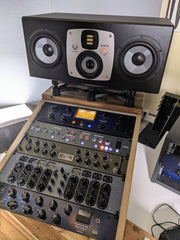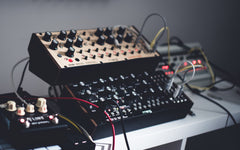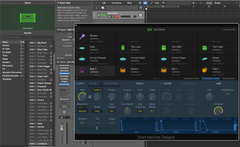Tutorial: Super Fast Arrangement in Ableton Live 10
There’s plenty of talk about capturing ideas or starting new music, but what about finishing? Here are all the ways you can work more quickly when arranging music in Ableton Live, in one place for easy reference.
Mastering arrangement workflows gives you the power to be fluid with your musical ideas after they’re recorded. It’s not when you want to be stumbling around the interface. The good news is, Ableton have included some significant improvements in that area in Live 10 and Live 10.1. Some of this is designed to be “discoverable” – Ableton has done user testing and responded to how we work. But that still means learning some keyboard shortcuts.
Here are both some general strategies and specific tips and tools to guide working more productively. And, of course, we’d love to hear some of your own ideas and add to this resource over time.
But don’t think of this as just a dull, dry manual you’ve got to dig through. Each of these methods has an accompanying musical application – some way you can use these chops to focus on assembling your ideas.

Use Session View to sketch out arrangements
Part of maximizing your creativity in Live is about understanding how to move material between Session and Arrangement – and it’s not always obvious.
First, you may want to reorganize a cluttered session into scenes. You can do that with a pair of commands:
Capture and Insert Scene / Duplicate. Select some clips that you like together, then choose Create > Capture and Insert Scene from the menu (or the Duplicate button on Ableton Push). This creates a new scene with the clips playing. Repeat with different clips selected, and you can build up a song structure.
Consolidate Time to New Scene. You can work in the opposite direction, too. Select a time range, and choose Create > Consolidate Time to New Scene, and you’ll get a scene with one clip per track.
Once you’ve done that, it’s possible to improvise – especially useful with Push and other controllers. The Record button in Live is technically called the “Arrangement Record” button for a reason: it’s designed to let you record not just in the way a conventional DAW does, but by capturing what you’re doing with clips and automation into the Arrangement View.
Okay, but what if you want to move individual clips? You can drag them in. CTRL-SHIFT-W brings up a second window to make this easier than dragging and dropping on the little Arrangement View icon. Even on a single display, this is a big timesaver (just put the windows side by side).
Organize parameters for automation, overdub automation
A composer will typically work with chosen parameters of sound, rhythm, and pitch. You can likewise organize parameters you want to use in your arrangement from your various instruments and effects.
Click the Fold/Unfold Device Parameters to show or hide all the various parameters of an Ableton device or a plug-in.
Plug-ins often have too many parameters to manage all at once. Click Configure, and then add/remove those parameters that are important to you. You can look in the plug-ins GUI, then click on a parameter to add it to the panel. Click on parameters on the panel, then press delete to remove them. Or drag them into a new order.

Better still:
Shift-click to select multiple devices and/or plug-ins, then choose Ctrl/Cmd-G to group them. This drops them into a Device Rack (Audio or Instrument), which means you have eight mappable macro controls. Mapping those lets you consolidate and organize what you most want to manipulate, and it means easy access on controllers – everything from Push to some of the cheapest third-party controllers out there has knobs that will map to this easily.

Once you have your parameters organized, you can choose Session Record to toggle automation overdubbing, then hit Record and play the mixing/automation you want live.
Learn the updated shortcuts in Arrangement View
Learning all the keyboard shortcuts will help, but specific additions in Live 10.1 (and Live 10 before it) really speed up what was once a sometimes-clumsy arrangement workflow.
First, don’t forget to toggle off the Computer MIDI keyboard, as it interferes with the ability to use these keyboard shortcuts.
Don’t miss:
F = fades. Fade envelopes on clips let you fade in and out audio material without volume automation. You can mouse over the edge of clips to get at them, but holding down F both reveals all the fade handles on all the clips, and ensures that you will definitely adjust the fade when you drag. (It’s otherwise easy to miss and accidentally select a time range – so this solves a big annoyance!)

Don’t squint:
+, - to scale a selected track.
Zoom with the mouse. Point your mouse at any track in the Arrangement View you want to zoom, and hold down ALT/OPT while scrolling your mouse wheel (or using scrolling on the trackpad). The selected track will zoom vertically.
H and W to fit everything to your screen. Pressing H and W toggles scaling the arrangement height and width, respectively. Combine it with –
Z and X to zoom to and from selected material. Got some detail you’re working on? Select it, hit Z, and you zoom in to that selection. Then hit X to zoom back out again.
Pinch and zoom. On trackpads from Apple and supported PCs, you can pinch to zoom the interface.
Manage automation quickly:
A to toggle automation. Working with automation and other arrangement separately is a time saver, especially once you get quick with zoom and automation toggling. Moving materials around, turn automation off. Changing mix, effect, and timbral parameters in automation, turn them on again. Then, once you’re editing automation:
Select time, then use handles to scale. When you select time, and (A)utomation is toggled on, you will now see tiny handles on the corners of the selection. Drag these, and you scale the entire automation in the selection. If there’s no automation at all, dragging creates it – meaning this is much, much faster than the way us old timers have always worked, clicking several times to create an automation shape.

Right click, then insert shapes. It’d be even better if Ableton created some keyboard shortcuts for this, but for now it already lets you quickly mouse-draw in some envelope patterns.

Enter precise values: Right click an automation point, choose Edit Value, type a number, then hit enter.
Control the mixer so you can hear what you’re doing:
S to solo/unsolo specific tracks. This is essential as you’re listening to your work as you edit.
Double-click to reset values. Useful when you need a reset of a mix.
Manage groups and navigate:
U and OPT/ALT-U unfold and fold groups.
Left and Right arrow keys move around. No more clumsy scrolling. The whole view will follow, too.
Working with clips and time.
A lot of arrangement can be done on the fly, working directly with clip material. It’s useful to remember these functions:
Split (Ctrl/Cmd-E): splits clips at the selection point, so you can divide up clip material. And its opposite:
Join (Ctrl/Cmd-J): joins them back together again. This pair now also works with automation (as of Live 10), which makes it freshly useful.
Deactivate clips. This is handy for clearing out overcrowded arrangements – just select a clip and press ‘0’ to disable it, while you decide whether you really need it or not. Combine with Clip and Join for still more compositional effectiveness.

Delete, Paste, Duplicate Time. These three commands lets you deal with whole blocks of time, across tracks at once.
Ctrl-Shift-Del = delete
Ctrl-Shift-D = duplicate
Ctrl-Shift-V = paste
Bounce multitrack audio
Sometimes, it’s quicker to just bounce everything to audio – just like the old multitrack tape days.
Live 10.1 made this much easier. Choose File > Export Audio/Video, then All Individual Tracks or Selected Tracks Only. (I typically delete unused sends right before this, too.)

The trick is the new “Include Return and Master Effects” toggle. With it on, it’s a way to create new stems but record any effects on sends, which used to be impossible. With it off, it can be useful for clearing away some reverbs or whatever else may have been cluttering a track and starting fresh.
If you switch on Create Analysis File, you can bring these into a new project quickly.
Watch Florian Meindl arrange analog recordings in Cubase
iOS, Android control
Ableton Push is heavily focused on the Session View. When CEO/founder Gerhard Behles introduced Push, he even described it as a way to start tracks. But that shouldn’t mean the mouse and keyboard are your only go-to choices when you want to finish them.
Touch controller apps are limited by Live’s API and tend to focus on Session View. But they’re still useful to keep at your side for access to editing clips, mixing, controlling devices, and even getting into the Browser. Two lead the pack with advanced features for going deep:
touchAble Pro, $29.99
Zerodebug
iOS, Android, Windows touch [plus Mac, Windows clients for the machine running Live]
https://zerodebug.com/touchablepro
LK, free + In-App Purchases
iOS, Android
Imaginando
https://www.imaginando.pt/products/lk
These two apps run on the phone, too, so you can even position your phone so you have quick access to features as you work (useful in cramped spaces).

ClyphX Pro for scripting
ClyphX Pro
Isotonik Studios
€41.64
This advanced desktop tool is a scripting language for Ableton Live. It’s meant for use by non-coders, too – you create simple wordings of Actions you want to perform, and trigger them from wherever you wish. It supports Arrangement locators, so you can also use it with the Arrangement View.
The key here is, you can set up advanced behaviors by chaining keystroke shortcuts. And you can map existing Ableton shortcuts to whatever you wish – including MIDI. That means you can navigate features you want to use quickly via MIDI controller or your keyboard. That’s probably a topic for another time.
New: Live coding transformations with a free hack
For even more advanced control, live, there’s a new “live coding” tool for Ableton Live. It’s called Mutateful, and it’s free and uses simple transformations (like arpeggiate or transpose) typed into Session View clips.
https://github.com/carrierdown/mutateful
So, for instance, this command adds an arpeggiator:
=B1 slice 1/2 transpose 0 7 slice 1/16 1/8 transpose -by C1
You can go crazy with this if you so desire, adding stutters and complex rhythms, or just make quick edits (like removing silences or making a clip monophonic). Insert this into the Session View approach above, and you can make more variations of your material for arrangements with more variety.
FREE Sample pack: 542 Techno Loops & Oneshots
Download in here: Free Sample Packs
Putting it together
Okay, so now you’ve got a lot of commands. Let’s review why this might help you make better music. Your workflow is this:
- Create some variety/chaos in Session View. No need to just have one groove and make it loop endlessly (especially with Mutateful in the mix).
- Organize that chaos into scenes – and organize parameters, possibly into Device Racks.
- Play your scenes to quickly populate your arrangement.
- Overdub some automation (as you play, or separately).
- Keep a second window handy for translating between Session and Arrangement as you move onto the finishing phase of your work.
- Get into editing, making use of the shortcuts to focus on automation or editing.
- Zoom in and select only what you want – without squinting, repeatedly missing with your mouse, or getting lost. (Been there!)
The ultimate goal of all this work is to make tracks with more variety and that come closer to what you imagine, without spending so much time mousing and fiddling and forgetting what your idea was.
PETER KIRN is a lifelong composer/musician and has used Live since version 1, among teaching and using various other tools. In addition to producing CDM (cdm.link) since 2005, he has released music on Detroit Underground, Instruments of Discipline, Kotä Records, Snork Enterprises, and his own Establishment. He has also worked with spatial sound, modern dance, and other fields.



